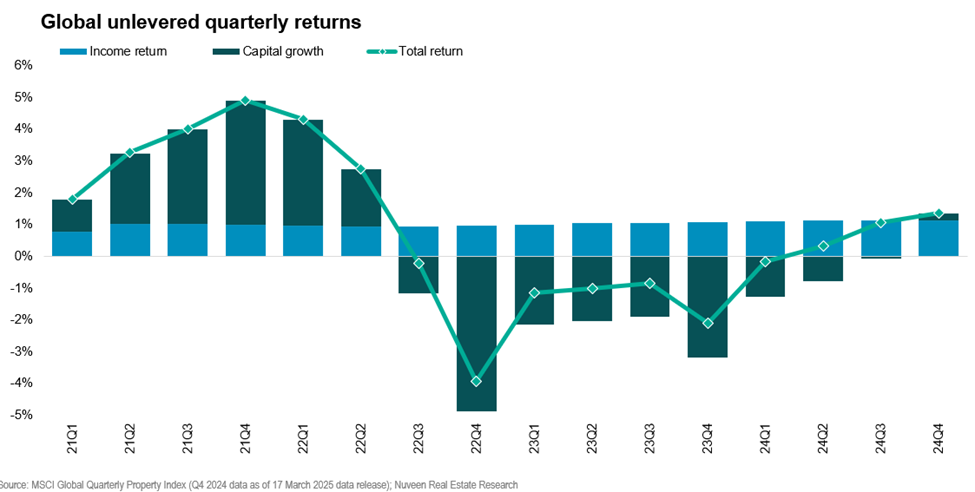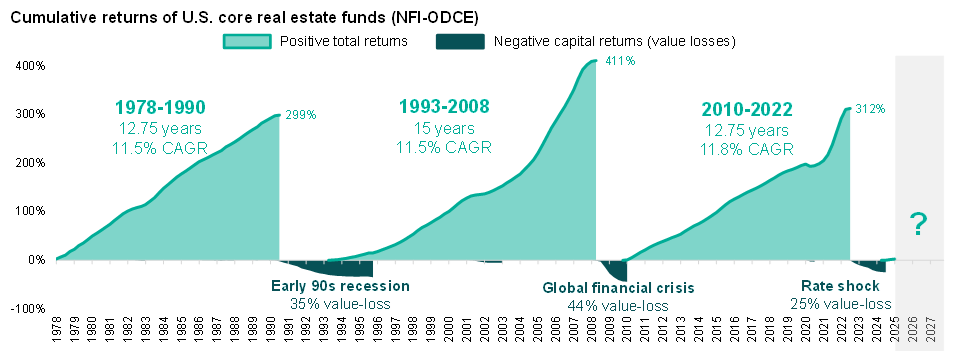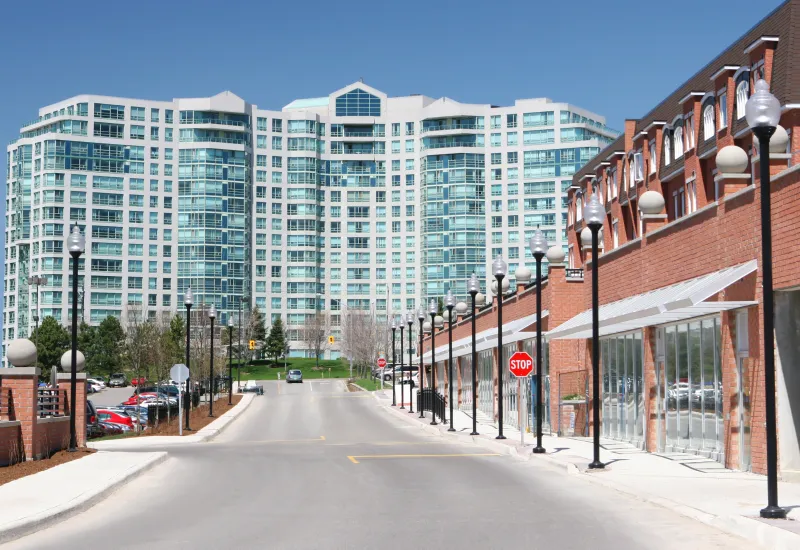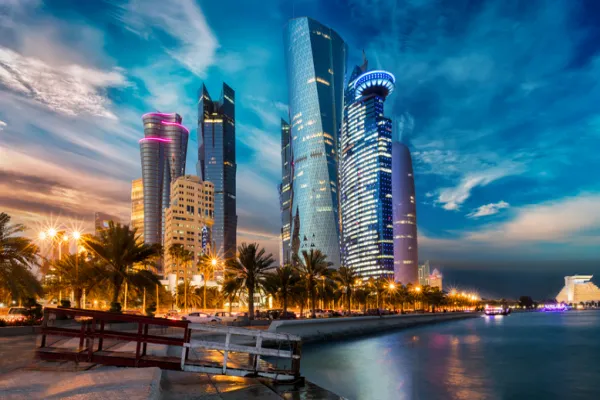As values stabilize, returns swing positive, and new supply dwindles, institutional investors are beginning to see encouraging signs that the sector is entering a phase of sustainable recovery. After a significant contraction between Q3 2022 and Q3 2024, the global real estate market is showing signs of a rebound. Almost 40% of global institutional investors are planning to increase allocations to private real estate over the next two years, according to Nuveen’s 2025 EQuilibrium survey. This is up from about 25% last year. Top sectors include data centers, industrial and residential. The survey also showed a significant jump in interest for self-storage assets among investors planning to increase allocations to private real estate, from 16% in 2024 to 29% in 2025.
Additionally, total global real estate capital flows to North America, Europe, and Asia-Pacific in H2 2024 rose 31% year-over-year to $37 billion in 2024, driven by defying expectations that political conflicts, interest rate risks, or macro headwinds might cause market friction ease1.
Geopolitical instability in Eastern Europe and U.S. tariffs have increased unease amongst institutional investors, but this is true across all asset classes – not just real estate. Relative to other asset classes, real estate enters this period of uncertainty significantly de-risked, having gone through its own correction over the last two and a half years. Investors today should consider more defensive property types like medical outpatient buildings, grocery-anchored retail, middle-market residential, and light industrial. Western Europe is also gaining interest from investors, having strong fundamentals, lower interest rates, greater probability of near-term rate cuts, and potentially the catalyst of the region working more closely together.
Market Stabilization and the Foundation for Recovery
The first signs of real estate’s rebound are rooted in three key indicators – value stabilization, improving total returns, and a sharp drop in new construction. Donald Hall, global head of research at Nuveen Real Estate, notes, “Values have reset significantly since the peak in 2022, down 16% on a global basis. Across most countries, we are seeing values are begin to notch marginal increases, suggesting that values have found their floor.”

The stabilization has translated into improved performance metrics. “Of the 21 countries in MSCI’s Global Property Index, 20 reported positive total returns in Q4 2024, and 17 delivered positive returns over the year,” says Hall. The recovery is also broad-based, cutting across both geographies and property types. In a breakdown of 51 country-sector combinations, 46 reported positive returns in the last quarter – a sign that the rebound is not only underway but widely distributed.
The slowdown in construction is another tailwind for market fundamentals. New construction starts have fallen off significantly, and as a result, new supply is set to be at the lowest level in over a decade across all sectors. Hall notes “As an owner of property, you prefer for there to be less new supply…a shiny new competing building across the street is typically not a benefit to any owner.”
Sector Highlights: Retail, Industrial, Multifamily, and Alts Lead the Way
While the broader market shows signs of recovery, certain sectors are emerging as clear outperformers. After many years out of favor, retail has emerged as a compelling opportunity which is starting to gain traction with investors. “Retail has been outperforming of late and the property sector has runway, especially in neighborhood and community retail. Vacancies are low, demand is resilient, and new construction seems virtually nonexistent,” says Hall.
The industrial sector, though seeing a moderation in rent growth from pandemic-fueled highs, still enjoys favorable long-term tailwinds. Additionally, many existing leases remain below current market rents as a result of the run-up of the last few years, providing a steady increase in renewal rents for years to come. For example, select markets including Charlotte, Columbus, and Phoenix have asking rents over 35% above average in-place rents. This supports income growth even as market rent growth moderates. The light industrial segment of the market has held up particularly well thanks to less new supply.
Multifamily is rebounding following four consecutive quarters of demand outpacing supply, which has caused occupancies to improve in most markets around the country. Occupancies in the Southeast are still lower than normal as a result of oversupply, but demand has been strong and the recovery has begun. Meanwhile, major markets that had been out of favor like Chicago and New York are seeing their time in the spotlight thanks to strong fundamentals and better-than-average rent growth.
Alternative sectors like medical office, self-storage, and senior living all have different drivers but continue to offer diversification benefits for investors as well as the potential for outsized returns. Medical outpatient buildings have vacancies at all-time lows and an aging demographic should help support demand going forward, similar to senior living.
Strategic Implications: A Window of Opportunity for Equity and Credit Investors
With values reset and fundamentals improving, this phase of the cycle represents a compelling entry point for long-term investors. There have been three major market upcycles in U.S. real estate since the beginning of the core open-ended fund universe - Historical patterns in U.S. real estate reveal that following each of the past three major downturns – spanning 1978 to 1990, 1993 to 2008, and 2010 to 2022. In each of these periods, – the market consistently delivered strong recoveries with average annual returns of 11.5%+ over periods of 13 to 15 years. Following a 25% decline in capital values over the last two years, similar conditions are emerging that suggest the potential for another long-term upswing.

Source: NCREIF Property Index ODCE returns
Although real estate equity investments are beginning to look compelling, real estate credit also continues to look favorable today. Hall notes that, “Today’s environment is ideal for credit investors – base rates are high, credit spreads are still wide, and asset values have reset, so loans should continue to de-risk as asset values increase and loan to values ratio fall. For new loans, default risk is low and returns are compelling, particularly on a risk-adjusted basis.”
Real Estate’s Rebound Has Legs
Global real estate’s recovery in 2025 is supported by tangible data and improving fundamentals. Stabilizing values, positive total returns, and historically low supply levels are providing a solid foundation for renewed growth. Transaction volumes are on the upswing as investors begin to rebalance into the asset class. As of Q1, trailing 12 month transaction volume was up 20% in both the U.S. and Europe.
Strategically, investors now face one of the more attractive entry points into real estate in recent years. Whether through equity investments or credit strategies, the opportunity set is broad. Hall notes, “There are three primary risks in real estate – falling values, oversupply, and weakening demand. With values reset and the peak of the supply cycle behind us, two of those three risks are substantially mitigated. Investors can mitigate the final risk by investing into sectors that have resilient demand drivers supported by long-term megatrends,” Hall notes. With values beginning to rise and with the supply cycle largely behind us, 2025 may well materialize as the beginning of a new, rewarding cycle for global real estate investors.
1CBRE Research. (2024). H2 2024 global real estate capital flows. CBRE. https://www.cbre.com/insights/reports/h2-2024-global-real-estate-capital-flows






